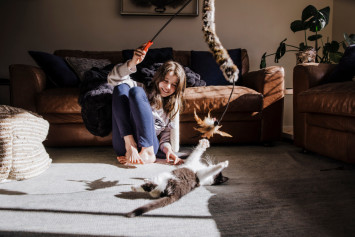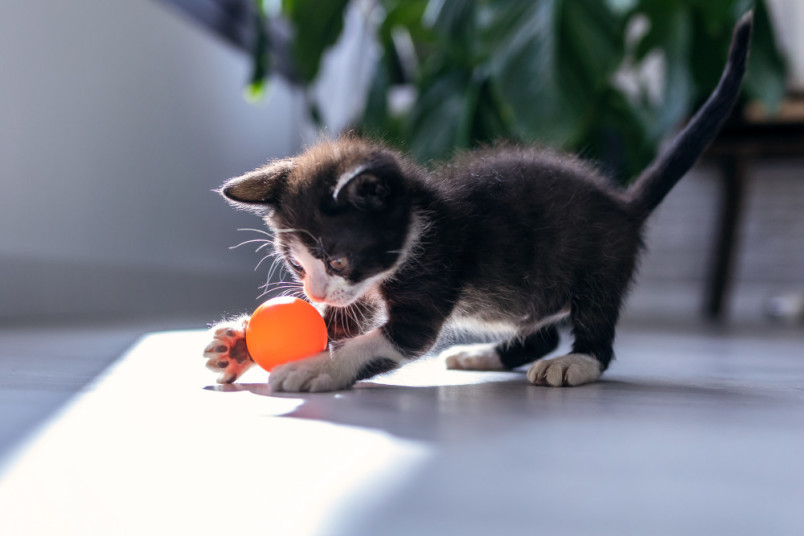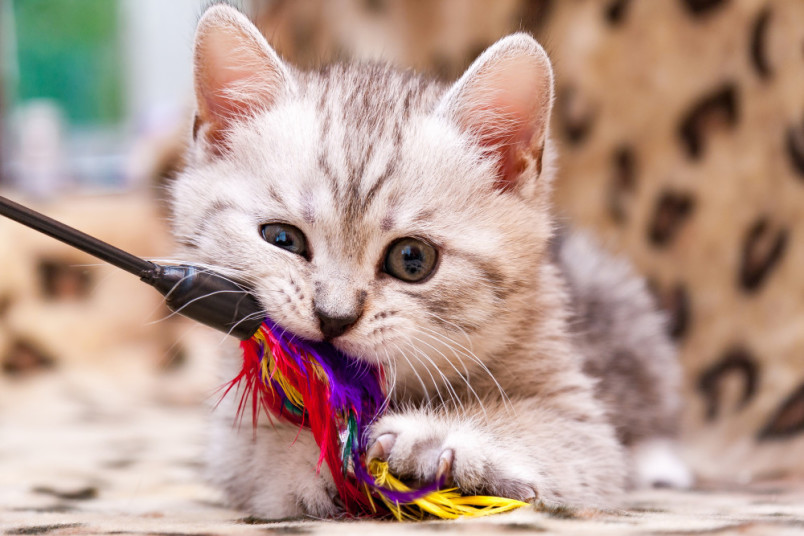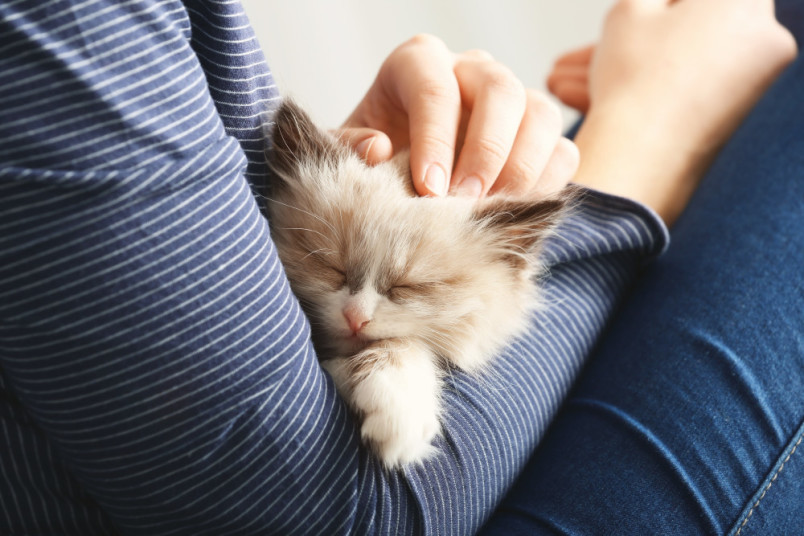
Wondering what to expect when you adopt a kitten? Kittens tend to have two modes: calm and cuddly or rambunctious and hyperactive. There is not much in between, especially during the first year. When watching them jump around and scale the walls and furniture, you may wonder, when will my kitten calm down? Don’t worry. The good news is most cats do calm down as they age.
Kitten Development and Milestones
Kittens develop very quickly, both physically and mentally, over their first year of life. When born, they cannot hear or see until up to 2 weeks of age when their eyes and ears open. During the first 2 months of life, they are still very reliant on their mother cat to keep them fed and clean. They have limited mobility, and nurse multiple times per day. This stage is comparable to an infant human, who sleeps a majority of the day, using their body’s energy primarily for growth.
Peak Age of Hyperactivity for Kittens
At around 2-3 months old, kittens are weaned from their mother’s milk and transition to wet food or kibble. These cute fluffy beings start to become more coordinated, but can still be seen stumbling and sliding around, especially when they get over-excited. This may be compared to the toddler stage in humans. Most owners note their cat becoming more energetic and bouncing off the walls. Our little predators begin to develop some of their instinctual drives to hunt, climb and scratch. They tend to be very social and active at this stage.
This is also the stage where it is important to know how often to take your cat to the vet. As kittens age, they lose the protective antibodies from mom’s milk and will need to be vaccinated to stay protected from certain common, contagious diseases. Be sure to consult your veterinarian regarding their recommended kitten vaccine schedule.
The “teen years” are from 6-12 months of age. As cats reach maturity, some will develop territorial behaviors such as marking, and scratching. Providing adequate areas for your cat to perform these behaviors benefits both you and them. Having multiple litterboxes of different styles and scratching posts around the house encourages your kitten to execute these behaviors in an appropriate fashion.

Cat Adulthood: When Cats Start to Settle Down
After their first birthday, your kitty is considered an adult and is typically its full-grown size. Many of our precious felines calm down considerably from 1-2 years of age on. They may still enjoy the occasional “zoomie” but tend to not get into as much mischief. Young adulthood continues until about 10 years of age, when most cats are still active, but much calmer. They tend to be more resistant to environmental changes at this age as they are well adapted to their surroundings and routine. They may be adverse to moving into a new home or the introduction of new furry family members.
After 10 years of age, your cat is considered a senior. At this age, many cats are much less active, and spend most of the day sleeping or sunbathing.
Reasons for Kitten Hyperactivity
Imagine a young tiger cub exploring their jungle and hunting for their next meal. Even domesticated cats still have an intrinsic want to hunt, climb and explore their environment as their ancestors did. You may notice your kitten sleeps a considerable amount during the day, but you hear the pitter-patter of running feet and the occasional crash at night. Cats still have an evolutionary nocturnal nature that drives them to be more active from dusk to dawn, especially when they are young and still learning their owner’s routine.
As they pounce about and scratch up your furniture, they are developing their hunting skills and marking their territory—actions that are instinctual to them. These behaviors can be destructive but are very important to your kitty’s enrichment and development, therefore it is necessary to have different avenues for them to fulfil these behaviors.
Tips for Calming Hyperactive Kittens
Environmental enrichment is the best way to make sure your kitten’s innate need to hunt, climb and scratch are met. This includes having toys and cat towers available for them to use at all times, encouraging them not to take their feelings out on the less-than-ideal options, like your furniture. Many cat trees and towers allow for climbing and often are combined with a scratching post. Having one of these is essential to owning a cat. For those crazy kitties who are a bit more stubborn and still enjoy the occasional destruction of the corner of your couch, you may consider furniture guards to protect it.

Importance of Interaction with Your Feline
Interacting with your furry feline is fundamental to addressing excessive energy and creating a bond with your new best friend. It is important to establish a routine with consistent mealtimes for your fur baby to help them regulate when to be active and when to be calm. Structured playtime allows them to have time to get some of their energy out and do so appropriately without getting into trouble. Cats enjoy toys that mimic prey to make them feel like they are true hunters. This includes toys such as feather fishing rods, laser pointers, small balls they can bat around, or even small battery powered fish or birds that they can wrestle and dominate. Some cats even enjoy the occasional leashed outdoor outing.
Last, but not least, consider getting a playmate for your kitten to help curb their bursts of energy. Rather than taking their energy out on you and your furniture, they pounce on and bat at another cat. Watching kittens roll around playfully and pounce on one another is one of the most enjoyable sights, sure to result in some laughter. If you would like to have more than one cat, introducing them when they are both young is likely to make for a smoother introduction and adaptation to one another.
Factors Affecting Calmness in Kittens
No two kittens are exactly alike, and each one holds a unique place in their owner's heart. While any kitten can have varying levels of energy and hyperactivity, there are a few factors that can influence a kitten’s energy level. Kittens who are weaned or separated from their mother cat too early tend to be more hyperactive and even aggressive. It is best not to complete weaning before 6 weeks of age to ensure your kitten gets all the nutrients it needs and learns manners from momma. Certain breeds tend to be more energetic than others, so this is another factor to consider when picking out a kitten best suited for you and your lifestyle.
One of the biggest factors leading to our kittens getting into mischief is lack of stimulation and attention. Interacting with your kitten and providing them with appropriate channels for the behaviors they are born to perform is important to their social and physical development.
When Will My Cat Calm Down?
Although sometimes frustration can lead, it is important to follow with patience when it comes to correcting your kitten’s behavior and helping them learn the appropriate alternative. Understanding the instinctual drive behind the sometimes not so ideal behaviors cats perform helps us as owners to provide appropriate outlets to stimulate our felines and let them fulfil their needs to hunt, climb, jump and scratch. But don’t worry, this especially active and exhausting phase will start to fade between their first and second birthdays.
If you have questions about your kitten’s behavior or there are any sudden changes to their behavior, remember that your veterinarian is a great resource for addressing your concerns. Getting your kitten insurance at a young age, prior to the development of potential pre-existing conditions is essential to feeling financially comfortable with your pet’s health. Cat insurance provides coverage for illnesses and emergencies, taking the financial burden out of the stress related to these often unexpected situations. As a pet owner, it is our responsibility to advocate for our cat’s health and well-being by being prepared for their health and enrichment needs and by teaching them to engage the environment we share with them appropriately.

Embracing Peace and Purrs: A Final Note on Kitten Calming
Remember, the whirlwind of kitten energy is just a temporary chapter in your feline friend's story. Embrace the cuddles, the playful pounces, and the zoomies (even if they leave your ankles a little worse for wear) because they're all part of the magic of raising a kitten. By providing enriching toys, establishing routines, and showering them with love and attention, you're not just helping them burn off steam, you're building a strong foundation for a lifelong bond. And when that day finally arrives, and your once hyperactive kitten transforms into a calm and cuddly companion, all those sleepless nights and furniture repairs will fade away, replaced by the purrfect contentment of sharing your home with a furry friend who finally found their inner peace.